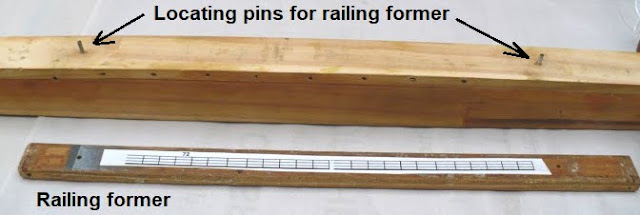Here is a jig that
I made for making the railings and ladders on my scratch built Titanic. It may
be of interest to ship bottlers and card modellers instead of using thread etc.
Railing & Ladder Jig.
The main frame consists of three pieces of wood. The two sides are curved along the top edge, allowing the top piece to be curved from end to end.
Railing & Ladder Jig.
The main frame consists of three pieces of wood. The two sides are curved along the top edge, allowing the top piece to be curved from end to end.
Tensioner view from top.
Tensioner view from underneath.
Jig view from underneath.
A drawing of the required railing is generated using MS paint or similar, printed out and glued to the railing former using a glue stick (Pritt).
Electrical or telephone wire is then wrapped around the former, following the outlines of the stanchions.
The former is then fitted over the locating pins on the jig.
The ends of the wires are tack soldered to stop them unravelling and wooden spacers are made and fitted at each end.
The tensioner is tightened to make the wires taught. The curvature of the jig ensures that the rail wires are pulled down onto the stanchion wires.
The wires are adjusted to lie over the lines of the drawing and then tack soldered at each end.
DO NOT PUT THE SOLDER ON THE WIRES.
Put a small amount of solder onto the tip of the iron and then put the tip on the wire joins. The flux will allow the solder to flow from the tip into the join.
When satisfied, reduce the tension and cut the wires from each end.
Cut the wires along one edge of the former.
Remove railing from former.
Trim off with knife.
Ready for painting.


















I just need to say this is a well-informed article which you have shared here about hoodies.Jigging Machine Supplier It is an engaging and gainful article for us. Continue imparting this sort of info, Thanks to you.
ReplyDelete